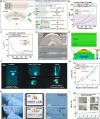Deployable electronics with enhanced fatigue resistance for crumpling and tension
- PMID: 39841835
- PMCID: PMC11753438
- DOI: 10.1126/sciadv.adr3654
Deployable electronics with enhanced fatigue resistance for crumpling and tension
Abstract
Highly packable and deployable electronics offer a variety of advantages in electronics and robotics by facilitating spatial efficiency. These electronics must endure extreme folding during packaging and tension to maintain a rigid structure in the deployment state. Here, we present foldable and robustly deployable electronics inspired by Plantago, characterized by their tolerance to folding and tension due to integration of tough veins within thin leaf. The primary design approach for these electronics involves a high resistance to folding and tension, achieved through a thin multilayered electronic composite, which manages the neutral axis and incorporates tough Kevlar. The fabricated electronics can be folded up to 750,000 times without malfunctions and endure pulling an object 6667 times heavier than itself without stretching. Such robust electronics can be used as a deployable robot with sensor arrays, demonstrating practical applicability, as it maintains their mechanical and electrical properties during inflation from the packaged state.
Figures




Similar articles
-
Ultrahigh Strain-Insensitive Integrated Hybrid Electronics Using Highly Stretchable Bilayer Liquid Metal Based Conductor.Adv Mater. 2023 Feb;35(5):e2208569. doi: 10.1002/adma.202208569. Epub 2022 Dec 15. Adv Mater. 2023. PMID: 36353902
-
Liquid Metal Fibers with a Knitted Structure for Wearable Electronics.Biosensors (Basel). 2023 Jul 7;13(7):715. doi: 10.3390/bios13070715. Biosensors (Basel). 2023. PMID: 37504113 Free PMC article.
-
Paper-like Foldable Nanowave Circuit with Ultralarge Curvature and Ultrahigh Stability.ACS Appl Mater Interfaces. 2019 Nov 20;11(46):43368-43375. doi: 10.1021/acsami.9b15697. Epub 2019 Nov 6. ACS Appl Mater Interfaces. 2019. PMID: 31650831
-
Skin-Inspired Electronics: An Emerging Paradigm.Acc Chem Res. 2018 May 15;51(5):1033-1045. doi: 10.1021/acs.accounts.8b00015. Epub 2018 Apr 25. Acc Chem Res. 2018. PMID: 29693379 Review.
-
Soft touchless sensors and touchless sensing for soft robots.Front Robot AI. 2024 Jan 18;11:1224216. doi: 10.3389/frobt.2024.1224216. eCollection 2024. Front Robot AI. 2024. PMID: 38312746 Free PMC article. Review.
References
-
- Fenci G. E., Currie N. G., Deployable structures classification: A review. Int. J. Space Struct. 32, 112–130 (2017).
-
- Song S., Fallegger F., Trouillet A., Kim K., Lacour S. P., Deployment of an electrocorticography system with a soft robotic actuator. Sci. Robot. 8, eadd1002 (2023). - PubMed
-
- Melancon D., Gorissen B., García-Mora C. J., Hoberman C., Bertoldi K., Multistable inflatable origami structures at the metre scale. Nature 592, 545–550 (2021). - PubMed
-
- Gao T., Bico J., Roman B., Pneumatic cells toward absolute Gaussian morphing. Science 381, 862–867 (2023). - PubMed
-
- Puig L., Barton A., Rando N., A review on large deployable structures for astrophysics missions. Acta Astronaut. 67, 12–26 (2010).
LinkOut - more resources
Full Text Sources

